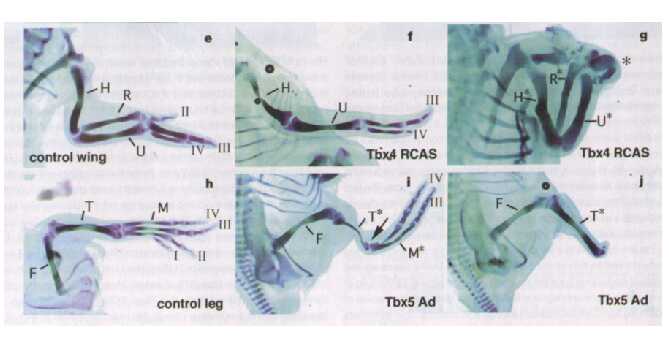
The paper I have chosen to critique was written by Takeuchi et al (1999) and is titled: Tbx5 and Tbx4 genes determine the wing/leg identity of limb buds, written for the Nara Institute of Science and Technology Graduate School in Japan.
The general idea of the paper is that because two members of the T-box family, Tbx4 and Tbx5, are expressed differently in leg and wing buds, respectivly. As a result, Tbx4 and Tbx5 might be involved, along with another gene Pitx1, in determining limb identity.
The authors used chick embryos to perform their mixexpression and tissue transplantation experiments; electroporated foreign DNA into limb fields early in development and observed the results. Thus, in this experimental setup, the researchers are measuring the amount of phenotypical morphological changes (dependant variable), as a result of misexpression of a gene or transplantation of tissue (dependant variable).
I find this paper to be fairly easy to read as the information is clearly and concisely presented along with descriptive interpretations of the figures shown. One drawback I see in their presentation is a lack of background and scope of complexity involved in the limb identification system. It is a short paper and is, consequently, not a paper that some one with limited knowledge about limb development could pick up and read. This paper is designed and targeted for the authors peers; those who have a vast background knowledge about the intricacies and going-ons with the gene cascades along with a keen knowledge of experimental procedures concerning developmental research. However, the feferences the author cites give more than enough background information, such that picking up any one would open a 'can of worms' into the deep universe of developmental biology.
I find this topic of research to be particularly interesting and relevant to the field of developmental biology as a lot of vertebrates including humans have legs and arms of some sort. For those animals that do not develop any appendages, such as snakes, worms, and eels, it would be interesting to see the sequence of events that would lead to the repression of development of limbs. On the other hand, it would also be interesting to see the genetic interactions that lead to multiple limbs in insects such as millipeds, centipeds, and spiders and in animals such as octopus. I'm sure that the T-Box genes, along with the other genes mentioned in this report, have some integral role in the development of these animals.
The evolutionary aspect of the T-Box genes is also an important field of study, as it would be interesting to know the role they played throughout the history of development, particularly in animals who gained or lost limbs as a result of natural development. One particularly interesting example is that of the whale, once a land mammal requiring arms and legs who returned to the sea, consequently losing legs. The whale still has some capabilities in himd limb development as rudimentary leg bone structure is present. Thus it would be interesting to see where in development the whale decides to stop himb limb development.
Another relevant aspect related to limb development is finding the role the T-Box genes play with regards to mutants and developmental diseases. It was mentioned that the Tbx5 mutant is involved in the Holt-Oram syndrome and no known mutant was found in Tbx4. Figuring out the genetic intricacies of limb development is crucial to understanding the Holt-Oram syndrome and possible treatments.

Figure 1. Box F and I depicts the absence or reduction of anterior digits in wing (top) and leg (bottom). Box G and J shows severe cases of developmental deformations where the limbs lacked the entire distal part of the limb (Rodriguez-Esteban et al 1999).
The paper written by Takeucki et al (1999) relates and is very applicable to the Principles of Animal Development course as the topic of limb development will be taught in class. Accordingly, the roles of some of the genes found in this report, such as the Hox genes and Pitx1, have been shown to be involved in other aspects of development (not to mention the article was hand-picked by Professor Crawford...hmm). In addition, the textbook correlates to material in the article, with the text being a useful tool in further understanding limb development.
All in all, I believe the experiments performed in the article were well thought out, including the novel system devised to over come the time-delay caused by traditional methods of introducing foreign DNA. However, I believe the title the author used for the article is a little decieving as it is not necessarily the T-Box genes that identify limb development. It was shown by Gibson-Brown et al (1998) that it is, in fact, the Hox genes which are expressed prior to the expression of the T-Box genes. Thus, it may in fact be the Hox genes which are responsible for regulating the expression of the T-Box genes within the limb fields; allowing the T-Box genes to regulate the expression of secreted molecules needed to instruct the tissue to develp the appropriate structures (Tbx5 fields develop into wings, Tbx4 fields develop into legs). Therefore, a more appropriate title may be that Tbx5 and Tbx4 influence the wing/leg identity, rather than determine.
Gene Interactions
Glossary of Terms
References
Go to the

Top